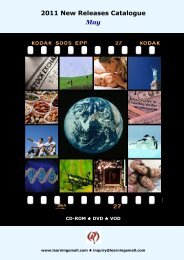2012 New Releases Catalogue November - Learningemall.com
2012 New Releases Catalogue November - Learningemall.com
2012 New Releases Catalogue November - Learningemall.com
Create successful ePaper yourself
Turn your PDF publications into a flip-book with our unique Google optimized e-Paper software.
action. Students learn how to use the<br />
nursing process to care for patients who<br />
are receiving drug therapy for angina,<br />
myocardial infarction, and cerebrovascular<br />
accident.<br />
Item no. : HG27340099<br />
Format : DVD<br />
Price : USD 156.00<br />
DRUGS DRUGS DRUGS FOR FOR FOR ANXIETY ANXIETY AN AND AN D<br />
INSOMNIA<br />
INSOMNIA<br />
This video lecture focuses on the major<br />
types of anxiety disorders, factors<br />
contributing to anxiety and explains some<br />
non-pharmacologic therapies used to<br />
cope with these disorders. It identifies the<br />
regions of the brain associated with<br />
anxiety, sleep, and wakefulness and<br />
suggests the three classes of medications<br />
used to treat anxiety and sleep disorders.<br />
The lecture explains the pharmacologic<br />
management of anxiety as it describes the<br />
nurse's role in the pharmacologic<br />
management of anxiety and insomnia.<br />
Students learn normal sleep patterns and<br />
how they might be affected by anxiety and<br />
stress. For each of classes listed in Drugs<br />
At A Glance, students should know the<br />
representative drugs and explains the<br />
mechanism of action, primary actions, and<br />
important adverse effects; and the use of<br />
steps of the nursing process to care for<br />
patients who are receiving drug therapy for<br />
anxiety and insomnia.<br />
Item no. : DY27340100<br />
Format : DVD<br />
Price : USD 156.00<br />
DRUGS DRUGS DRUGS FOR FOR FOR BACTERIAL<br />
BACTERIAL<br />
INFECTIONS<br />
INFECTIONS<br />
This video <strong>com</strong>pares and contrasts the<br />
terms pathogenicity and virulence and<br />
how bacteria are classified. It looks at the<br />
terms bacteriostatic and bacteriocidal<br />
used in control of bacterial growth curve<br />
and with specific example, explains how<br />
resistance can develop to an anti-infective<br />
drug. The lecture describes the nurse's<br />
role in the pharmacologic management of<br />
bacterial infections. It explains the<br />
importance of culture and sensitivity<br />
testing to anti-infective chemotherapy and<br />
mechanisms of development and<br />
symptoms of superinfections caused by<br />
anti-infective therapy. For each of the drug<br />
classes listed in Drugs at a Glance, it<br />
explains the mechanism of drug action,<br />
primary actions, and important adverse<br />
effects. The video categorizes<br />
antibacterial drugs based on their<br />
classifications and mechanisms of action<br />
and explains how the pharmacotherapy of<br />
tuberculosis differs from that of other<br />
infections. Students learn how to use the<br />
nursing process to care for patients who<br />
are receiving drug therapy for bacterial<br />
infections.<br />
Item no. : SP27340101<br />
Format : DVD<br />
Price : USD 156.00<br />
DRUGS DRUGS DRUGS FOR FOR COAGULATIO<br />
COAGULATION<br />
COAGULATIO<br />
COAGULATIO N<br />
DISORDERS<br />
DISORDERS<br />
The video constructs a flow chart<br />
diagramming the important steps of<br />
hemostasis and fibrinolysis as it describes<br />
thromboembolic disorders that are<br />
indications for coagulation modifiers. It<br />
identifies the primary mechanisms by<br />
which coagulation-modifier drugs act and<br />
laboratory testing of coagulation<br />
parameters is used to monitor<br />
anticoagulant pharmacotherapy. For each<br />
of the classes listed in Drugs at a Glance,<br />
it explains the mechanism of drug action,<br />
primary actions, and important adverse<br />
effects. The video categorizes<br />
coagulation-modifying drugs based on<br />
their classifications and mechanism of<br />
action and students learn how to use the<br />
nursing process to care for patients<br />
receiving drug therapy for coagulation<br />
disorders.<br />
Item no. : GT27340102<br />
Format : DVD<br />
Price : USD 156.00<br />
DRUGS DRUGS FOR<br />
FOR<br />
DEGENERATIVE DEGENERATIVE DEGENERATIVE DISEASE DISEASES<br />
DISEASE S<br />
OF OF THE THE THE CENTRAL<br />
CENTRAL<br />
NERVOUS NERVOUS SYSTEM<br />
SYSTEM<br />
This video describes the most <strong>com</strong>mon<br />
degenerative diseases of the CNS;<br />
specifically it looks at the signs and<br />
symptoms of Parkinson's disease, its<br />
neurochemical basis, focusing on the roles<br />
of dopamine and acetylcholine in the brain.<br />
The lecture describes the nurse's role in<br />
the pharmacological management of<br />
Parkinson's disease and Alzheimer's<br />
disease. For each of the drug classes<br />
listed in Drugs at a Glance, it explains the<br />
mechanism of drug action, primary actions,<br />
and important adverse effects. Secondly, it<br />
describes signs and symptoms of<br />
Alzheimer's disease and explains theories<br />
about why these symptoms develop and<br />
the goals of pharmacotherapy and the<br />
efficacy of existing medications. The<br />
lecture categorizes drugs used in the<br />
treatment of Alzheimer's disease and<br />
Parkinson's disease based on their<br />
classifications and mechanisms of action<br />
and the nursing process to care for<br />
patients receiving drug therapy for<br />
degenerative diseases of the central<br />
nervous system.<br />
Item no. : EG27340103<br />
Format : DVD<br />
Price : USD 156.00<br />
DRUGS DRUGS FOR<br />
FOR<br />
DYSRHYTHMIAS<br />
YSRHYTHMIAS<br />
This video relates how rhythm<br />
abnormalities can affect cardiac function; it<br />
illustrates the flow of electrical impulses<br />
through the normal heart and classifies<br />
dysrhythmias based on their locations and<br />
types of rhythm abnormality. The lecture<br />
explains how an action potential is<br />
controlled by the flow of sodium,<br />
potassium, and calcium ions across the<br />
myocardial membrane and the importance<br />
of non-pharmacologic therapies in the<br />
treatment of dysrhythmias. Students learn<br />
the primary mechanisms by which<br />
antidysrhythmic drugs act and the nurse's<br />
role in the pharmacologic management of<br />
patients with dysrhythmias. The<br />
representative drug examples for each of<br />
the drug classes listed in Drugs at a<br />
Glance, and explanation of the<br />
mechanism of action, primary actions, and<br />
important adverse effects, category<br />
antidysrhythmic drugs based on their<br />
classification and mechanism of action are<br />
discusses. Students learn how to use the<br />
nursing process to care for patients<br />
receiving drug therapy for dysrhythmias.<br />
Item no. : TW27340104<br />
Format : DVD<br />
Price : USD 156.00<br />
DRUGS DRUGS FOR FOR EMOTIONAL<br />
EMOTIONAL<br />
AND AND MOOD MOOD DISORDERS<br />
DISORDERS<br />
This video identifies the major categories<br />
of mood disorders and their symptoms,<br />
etiology of clinical depression and the<br />
nurse's role in the pharmacological<br />
management of depression, bipolar<br />
disorder, and attention-deficit-hyperactivity<br />
disorder. It covers symptoms of<br />
attention-deficit-hyperactivity disorder<br />
(ADHD) and demands students to know<br />
representative drug examples for each of<br />
the drug classes listed in Drugs at a<br />
Glance, and explains the mechanism of<br />
action, primary actions, and important<br />
adverse effects together with categorizing<br />
drugs used for mood and emotional<br />
disorders based on their classification and<br />
drug action. Students learn how to use the<br />
nursing process to care for patients<br />
receiving drug therapy for mood and<br />
emotional disorders.<br />
Item no. : LT27340105<br />
Format : DVD<br />
Price : USD 156.00<br />
DRUGS DRUGS FOR FOR HEART<br />
HEART<br />
FAILURE<br />
FAILURE<br />
This video describes major risk factors<br />
associated with heart failure as it relates<br />
how the classic signs and symptoms<br />
associated with heart failure may be<br />
caused by weakened heart muscle. It<br />
explains how preload and afterload affect<br />
cardiac function and the nurse's role in the<br />
pharmacologic management of heart<br />
failure. The representative drug examples<br />
for each of the drug classes listed in Drugs<br />
at a Glance, and explanation of the<br />
mechanism of action, primary actions,<br />
important adverse effects, category of<br />
heart failure drugs based on their<br />
classification and mechanism of action are<br />
discussed. Students learn how to use the<br />
steps of the nursing process to care for<br />
patients who are receiving drug therapy for<br />
heart failure.<br />
________________________________________________________________________________________________________<br />
Learning Rendezvous Limited<br />
Email: inquiry@learningemall.<strong>com</strong> Websites: http://www.learningemall.<strong>com</strong> & http://www.learningemall.<strong>com</strong>.hk<br />
103














